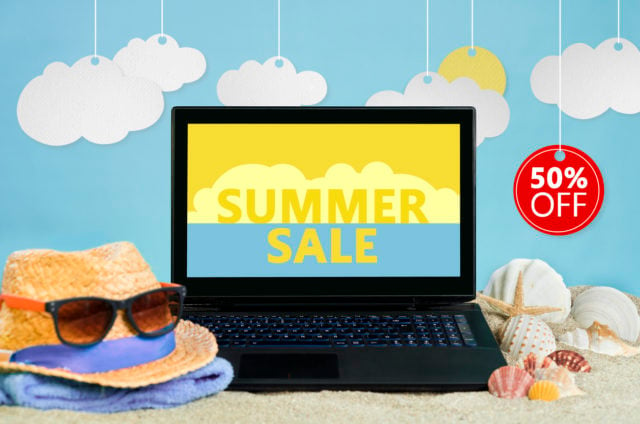Email marketing is still the most powerful way to engage your audience and maintain customer loyalty for your eCommerce business. Consider these mind-blowing facts about email marketing from a recent online article:
- Welcome emails convert to sales. They increase your revenue stream by 320 percent over the average promotional email.
- Customers who are prompted to make purchases from email campaigns increase their spend by 138 percent.
- 80 percent of eCommerce businesses report that email marketing is still their most powerful tool for customer retention.
- The number of email users in the U.S. is projected to grow to 254.7 million by 2020.
- For every dollar you spend on email marketing, you’re likely to get an ROI of $44.
And in case you thought young consumers don’t use emails, reports say otherwise: 73 percent of millennials still favor email over other marketing efforts, like social media posts or SMS. The only difference is that millennials are viewing their email campaigns on their smartphones.
Holidays: The Greatest Opportunity for Successful Email Marketing Campaigns
If you’re not preparing your email marketing campaigns for the next big holiday, you risk handing your revenue over to companies that are. Successful eCommerce businesses monitor holiday spending closely and create entire email marketing strategies around these big shopping seasons.
Which holidays top the list with their impressive spending figures?
- Winter holidays, primarily Christmas and Thanksgiving: $626 billion
- Black Friday: $5 billion in 24 hours
- Cyber Monday: $6.59 billion, up 16.8 percent from the previous year
- Mother’s Day: $21 billion
- Valentine’s Day: $19 billion
- Easter: $16 billion
- Labor Day Weekend: $13 billion
- Father’s Day: $12 billion
- Halloween: $6 billion
- Independence Day: $6.9 billion
- Patrick’s Day: $4 billion
Though not holidays, other times during the year with high consumer spending include:
- Back-to-school shopping: $68 billion
- Super Bowl: $15.5 billion
Create an Email Marketing Timeline Leading Up to a Holiday
To be successful at holiday email marketing, you need to develop a timeline for building campaigns that lead up to the busiest quarter of the year. To give you an idea of what we’re talking about, let’s focus on when Americans increase their spending: Back-to-school shopping and Labor Day weekend.
Back-to-School

The back-to-school season for preschoolers to college students can start as early as mid-July and last until mid-September. The reason it continues a few weeks after school has started is that — as with many holidays — most retailers will offer post-season clearance sales. So, your email marketing strategy could theoretically be broken down into three waves:
- A pre-season “It’s Almost Time to Shop for Back-to-School Essentials” campaign
- A “Back-to-School Savings Starts Now” email campaign series
- A “Take Advantage of After-Season Savings” campaign to end the season
Pre-Season: Your pre-season timeline may look something like this:
Six months out: Consult your team and formulate your strategy. Perform exhaustive research, gather ideas and then refine your email campaigns. Just keep in mind to leave some room for last minute adjustments.
Three months out: Your campaigns are ready to launch. By now, there should be no more adjustments. All images, graphics, email templates, content and targeted audience should be finalized and ready to deploy when it’s time.
Pre-Season Launch: Ideally, you want to launch your pre-season campaign early to mid-July. A recent study found that the peak spending season begins as early as July 8 and runs through August, bringing in $83.6 billion in 2017. When you start the campaign and how often you send your emails — daily, weekly — will depend on factors such as your products or services, the size of your company and the breadth of your marketing portfolio.
During the Season: Your back-to-school email campaigns will follow the same format as your pre-season campaign. You will plan several months out, finalize the campaign three to four months in advance, and then launch. The difference is that you’ve already laid the groundwork to prepare your audience for unique offers. Now, you’re simply reinforcing your pre-season campaigns by announcing sales and promotions as they happen in real-time.
Since back-to-school season lasts through August, you will need to plan your campaigns accordingly to capture conversations and valuable revenue during this busy spending season.
Post-Season: Just like at Christmas, Halloween and Easter, most companies wind up with a surplus of inventory to clear out after the shopping season ends. If your eCommerce business falls in this category, you’ll want to promote a clearance sale to maximize your marketing efforts and capture any remaining revenue.
Post-season campaigns should revolve around the idea that consumers can save a lot of money by taking advantage of after-season sales. In most cases, you’ll only get one or two opportunities to appeal to postseason buyers. Therefore, the wrap-up may only last three to five days after the season has ended — usually in the first week or two of September.
Labor Day

Not all holidays require the same email marketing approach. Long seasons like fall/winter holidays require months of planning and a tremendous amount of effort to launch a successful campaign.
Labor Day differs from extended holidays in that it does not have the anticipation period other seasons do, but it is a big retail shopping day. In fact, 58 percent of Americans are planning on participating in the big sales, especially for items like clothing, school supplies and electronics.
So how should you formulate your email campaign for this holiday? You can follow a similar plan to the approach for back-to-school shopping. You’ll want to catch your audience when Labor Day first crosses their mind. This generally happens seven to 10 days out, so your pre-weekend launch needs to occur one to two weeks before the holiday.
Weekend Launch: Different companies offer different types of Labor Day sales. For instance, some companies have deals that last the entire weekend. Others may choose to have a one-day-only sale on that Monday.
If your sale is all weekend, send an email campaign to announce the start of the sale and then send daily reminders that contain urgent information on stock levels and special incentives.
If your sale is Monday only, you are still technically in pre-sale mode during the weekend. Either way, your weekend emails are a way to motivate your audience to go online or visit your storefront to start planning their purchases.
Post-Labor Day: If your marketing strategy is wildly successful, you probably won’t have a post-Labor Day campaign. Now is the time to plan your next campaign or start looking at your plan for the impending holiday season.
Maintain Your Subscriber List
By now you’ve amassed a sizable subscriber list. Like all other components in your eCommerce business, you’ll need to update this list regularly and perform routine maintenance to ensure the health of your data. That includes adding to and cleaning out your list. Cleaning out your data requires some methodology and purpose. You need to establish why some contacts will go and why some will stay.
Start by dividing your contacts into three main categories:
- Inactive users: These are contacts that have never ordered from your eCommerce store or who haven’t ordered in quite a while, giving you no indication that they will change that behavior.
- Moderately-engaged users: These are customers that make an occasional purchase. They may be waiting for promotions or specific inventory to arrive before converting to a sale.
- Highly-engaged users: These are your A-listers. They love your brand and the products or services you offer. Plus, they are your most frequent, high-dollar customers, and they frequently share your emails or social media posts with others.
You want to start by clearing out your inactive users. Before you do, however, you should create an email campaign that targets this group. Send them a special promotion or an email that asks them if they would like to keep receiving your emails.
From there, you want to clean up bounced email addresses or miscellaneous data that may be hurting your marketing efforts. The simple task of deleting emails that bounce can help boost your open and click-through rates.
That’s because you’ll only be sending email campaigns to people who want to receive them. Plus, with a little list hygiene, you’ll increase your online reputation as a trusted sender.
Lastly, you should reach out to your moderate and highly-active leads. You can employ different strategies such as thank you emails, newsletters, links to blogs or special promotions geared to increase revenue.
It’s a good idea to establish a routine to maintain your user data. Experts recommend that you clean out your subscriber list once every three months if you’re sending out one or more emails per month.
Comply With the 2018 GDPR Policy
Earlier this year, European businesses were subject to the General Data Protection Regulation (GDPR) to fortify data protection and privacy for consumers within the European Union. eCommerce businesses worldwide must comply with GDPR or face stiff fines and penalties that could result in loss of revenue streams.
With the GDPR already in effect, consumers now have full control of how their data is gathered, used and shared. The EU defines personal data as “any information relating to an identified or identifiable natural person,” including birthday, address, phone number, salary, rent and IP address.
If you process this data for business purposes, you must comply with the GDPR, even if your eCommerce company is based in the U.S.
The GDPR protects consumers in the following ways:
- Informing consumers when their information is accessed
- Giving users direct access to companies that are using their information
- Holding companies accountable for violations of the GDPR
- Giving consumers the ability to erase information or restrict processing
- Allowing consumers to object to processing, automated processing and profiling
If you are currently gathering information from EU consumers, it’s important to make sure you are GDPR-compliant.
Utilize Springbot Exchange and Audience Expander
Springbot has recently launched Springbot Exchange for small to medium-size businesses (SMBs). This innovative marketing tool grants you access to the same high-level resources that nationwide retailers use to boost their influence. With the Audience Expander, you can leverage your business and gain new customers in markets that may otherwise be out of your reach.
How does it work?
Audience Expander identifies prospects that are similar to your existing customer base. It performs this function by processing a series of algorithms so that the matches are accurate and target the right demographic. You can use this information for a wide range of operations such as:
- Generating automated email marketing campaigns
- Viewing your potential customers anonymously and securely
- Viewing data from participating Springbot retailers and partners
- Collecting information across a broad set of verticals
Prepping for the Holidays
With proper planning and a well thought-out strategy, you can build a loyal customer base with email marketing.
Sharpen your marketing skills during summer shopping seasons like Labor Day and back-to-school shopping, and offer special promotions to re-engage your subscribers and get them ready for the holiday season. Now is the perfect time to clean up your subscriber list. Perform some routine maintenance and you’ll be rewarded with a healthy list of valuable customers who are primed to respond to your promotions.
Using the right tools such as Springbot Exchange and Audience Expander will help broaden your customer base while increasing your eCommerce conversions. In no time, you’ll be prepped for success for the impending holiday shopping season to capture record revenue and grow your brand’s reputation.





